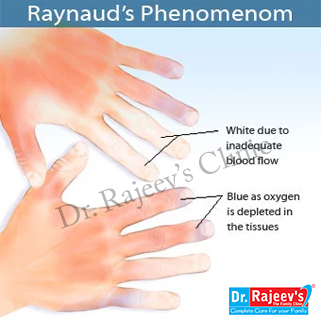

A young complains of one or more fingers going dead suddenly for an hour or more. This occurs symmetrically on both the sides, especially in cold weather. In a long standing case, an ulcer may form at the tip of the finger. The condition is RAYNAUD'S DISEASE.

Raynauds phenomena consists of spasms of arteries supplying the fingers or toes. It is usually precipitated by cold and relieved by heat. When raynauds phenomena occurs without any underlying causes, it is known as raynauds disease. Numbness and burning of the fingers usually occurs and the pain can be severe. Between the attacks, the pulse and the digits appear normal.
Signs and symptoms of Raynaud's disease include:
During an attack of Raynaud's, affected areas of your skin usually first turn white. Then, they often turn blue and feel cold and numb. As you warm and your circulation improves, the affected areas may turn red, throb, tingle or swell.
Although Raynaud's most commonly affects your fingers and toes, it can also affect other areas of your body, such as your nose, lips, ears and even nipples. After you warm up, the return of normal blood flow to the area can take 15 minutes.
With Raynaud's, arteries of fingers and toes become narrow and briefly limit blood supply when exposed to cold or stress. Over time, these small arteries can thicken slightly, further limiting blood flow.
Cold temperatures are most likely to trigger an attack. Exposure to cold, such as putting your hands in cold water, taking something from a freezer or being in cold air, is the most likely trigger. For some people, emotional stress can trigger an episode.
Secondary Raynaud's. Also called Raynaud's phenomenon, this form is caused by an underlying problem. Although secondary Raynaud's is less common than the primary form, it tends to be more serious.
Signs and symptoms of secondary Raynaud's usually appear around age 40, later than they do for primary Raynaud's.
Risk factors for primary Raynaud's include:
Risk factors for secondary Raynaud's include:
If secondary Raynaud's is severe — which is rare — reduced blood flow to your fingers or toes could cause tissue damage.
A completely blocked artery can lead to sores (skin ulcers) or dead tissue, both of which can be difficult to treat. Rarely, extreme untreated cases might require removing the affected part of your body.
To help prevent Raynaud's attacks:
Bundle up outdoors. When it's cold, don a hat, scarf, socks and boots, and two layers of mittens or gloves before you g
Also use chemical hand warmers. Wear earmuffs and a face mask if the tip of your nose and your earlobes are sensitive to cold.
o outside. Wear a coat with snug cuffs to go around your mittens or gloves, to prevent cold air from reaching your hands.
Take precautions indoors. Wear socks. When taking food out of the refrigerator or freezer, wear gloves, mittens or oven mitts. Some people find it helpful to wear mittens and socks to bed during winter.
Because air conditioning can trigger attacks, set your air conditioner to a warmer temperature. Use insulated drinking glasses.
Agaricus muscarius is a prominent remedy for chilblains and frostbite with itching, burning band redness. Sensation as if pierced with ice needles. Gait is uncertain with trembling; itching of the toes and feet feel as if frozen.
Silicea terra has shriveled, mottled, dusky blue, numb skin. Formication. Burning sensation in toes and fingers, better by cold, aversion to heat.
Rhus toxicodendron is for gangrenous ulcers on the legs, running bloody water. Extremities are cold. Red, swollen toes and fingers tips that itch and burn intensely, as if pierced by hot needles; better hot water.
Sepia officianalis has poor circulation and venous stasis. Both these factors predispose to gangrene.